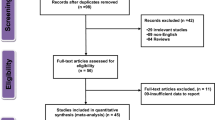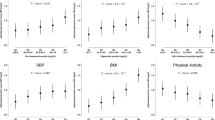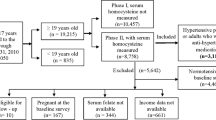Abstract
Increased levels of plasma total homocysteine (tHcy) can be caused by genetic mutations, vitamin deficiencies, renal and other diseases, and numerous drugs. Raised tHcy also correlate with increasing age, and are associated with laboratory evidence of atherogenesis (e.g. endothelial dysfunction) and thrombosis, and with epidemiological evidence of an increased risk of atherothrombotic vascular disease, including ischemic stroke. The association between raised tHcy and increased risk of ischemic stroke is independent of other known vascular risk factors and is biologically plausible; however, randomized controlled trials have not revealed a causal relationship. The recently published Vitamins In Stroke Prevention (VISP) trial identified no significant reduction in the relative risk of stroke by lowering tHcy with B-vitamin therapy among 3,680 patients with recent ischemic stroke. It did not, however, reliably exclude a modest but important reduction of up to 20% in relative risk of stroke. Currently, there is insufficient evidence to confirm that homocysteine is a modifiable causal risk factor for stroke, or to recommend routine screening for, or treatment of, raised tHcy concentrations with folic acid and other vitamins, to prevent ischemic stroke.
Key Points
-
The hypothesis that high levels of plasma total homocysteine (tHcy) might predispose people to atherothrombosis and ischemic stroke was based on the observation that patients with homocystinuria are particularly susceptible to vascular disease and premature death from myocardial infarction
-
Evidence from laboratory studies, epidemiology and clinical trials support a correlation between elevated tHcy and stroke, but there is limited evidence for a causal relationship
-
The homocysteine hypothesis is currently being tested by at least 12 large ongoing clinical trials, involving more than 50,000 patients
-
B-vitamin therapy has been shown to be effective at reducing tHcy levels, but there are insufficient reliable data from large randomized controlled trials to indicate that B-vitamin therapy is effective for preventing clinical vascular events
This is a preview of subscription content, access via your institution
Access options
Subscribe to this journal
Receive 12 print issues and online access
$209.00 per year
only $17.42 per issue
Buy this article
- Purchase on Springer Link
- Instant access to full article PDF
Prices may be subject to local taxes which are calculated during checkout

Similar content being viewed by others
References
Mudd SH et al. (2000) Homocysteine and its disulfide derivatives: a suggested consensus terminology. Arterioscler Thromb Vasc Biol 20: 1704–1706
D'Angelo A and Selhub J (1997) Homocysteine and thrombotic disease. Blood 90: 1–11
Moat SJ et al. (2004) Folate, homocysteine, endothelial function and cardiovascular disease. J Nutr Biochem 15: 64–79
McCully KS (1969) Vascular pathology of homocysteinemia: implications for the pathogenesis of arteriosclerosis. Am J Pathol 56: 111–128
Refsum H et al. (2004) Facts and recommendations about total homocysteine determinations: an expert opinion. Clin Chem 50: 3–32
Desouza C et al. (2002) Drugs affecting homocysteine metabolism: impact on cardiovascular risk. Drugs 62: 605–616
Homocysteine Lowering Trialists' Collaboration (1998) Lowering blood homocysteine with folic acid based supplements: meta-analysis of randomised trials. BMJ 316: 894–898
Van Guldener C et al. (1999) Effect of folic acid and betaine on fasting and postmethionine-loading plasma homocysteine and methionine levels in chronic haemodialysis patients. J Intern Med 245: 175–183
Toole JF et al. (2004) Lowering homocysteine in patients with ischemic stroke to prevent recurrent stroke, myocardial infarction and death: the Vitamin Intervention for Stroke Prevention (VISP) randomized controlled trial. JAMA 291: 565–575
Hankey GJ et al. (2004) Is there really a power shortage in clinical trials testing the “homocysteine hypothesis”? Arterioscler Thromb Vasc Biol 24: e147
Dusitanond P et al. (2005) Homocysteine-lowering treatment with folic acid, cobalamin and pyridoxine does not reduce blood markers of inflammation, endothelial dysfunction or hypercoagulability in patients with previous transient ischemic attack or stroke: a randomised substudy of the VITATOPS trial. Stroke 36: 144–146
Symons JD et al. (2002) Hyperhomocysteinemia evoked by folate depletion: effects on coronary and carotid arterial function. Arterioscler Thromb Vasc Biol 22: 772–780
Faraci FM (2003) Hyperhomocysteinemia: a million ways to lose control. Arterioscler Thromb Vasc Biol 23: 371–373
Faraci FM and Lentz SR (2004) Hyperhomocysteinemia, oxidative stress, and cerebral vascular dysfunction. Stroke 35: 345–347
Homocysteine Studies Collaboration (2002) Homocysteine and risk of ischemic heart disease and stroke: a meta-analysis. JAMA 288: 2015–2022
Wald DS et al. (2002) Homocysteine and cardiovascular disease: evidence on causality from a meta-analysis. BMJ 325: 1202–1206
Bazzano LA et al. (2002) Dietary intake of folate and risk of stroke in US men and women: NHAMES I Epidemiologic Follow-up Study. Stroke 33: 1183–1189
He K et al. (2004) Folate, vitamin B6, and B12 intakes in relation to risk of stroke among men. Stroke 35: 169–174
Klerk M et al. (2002) MTHFR 677C→T polymorphism and risk of coronary heart disease: a meta-analysis. JAMA 288: 2023–2031
Casas JP et al. (2005) Homocysteine and stroke: evidence on a causal link from mendelian randomisation. Lancet 365: 224–232
Peterson JC and Spence JD (1998) Vitamins and progression of atherosclerosis in hyper-homocyst(e)inaemia. Lancet 351: 263
Hackam DG et al. (2000) What level of plasma homocyst(e)ine should be treated? Effects of vitamin therapy on progression of carotid atherosclerosis in patients with homocyst(e)ine levels above and below 14μM/l. Am J Hypertens 13: 105–110
Marcucci R et al. (2003) Vitamin supplementation reduces the progression of atherosclerosis in hyperhomocysteinaemic renal-transplant recipients. Transplantation 75: 1551–1555
Vermeulen EG et al. (2000) Effect of homocysteine-lowering treatment with folic acid plus vitamin B6 on progression of subclinical atherosclerosis: a randomised, placebo-controlled trial. Lancet 355: 517–522
Schnyder G et al. (2001) Decreased rate of coronary restenosis after lowering of plasma homocysteine levels. N Engl J Med 345: 1593–1600
Schnyder G et al. (2002) Effect of homocysteine-lowering therapy with folic acid, vitamin B12, and vitamin B6 on clinical outcome after percutaneous coronary intervention: the Swiss Heart study: a randomized controlled trial. JAMA 288: 973–979
Lange H et al. (2004) Folate therapy and in-stent restenosis after coronary stenting. N Engl J Med 350: 2673–2681
Lawlor DA et al. (2004) Those confounded vitamins: what can we learn from the differences between observational versus randomised trial evidence? Lancet 363: 1724–1727
Dudman NP (1999) An alternative view of homocysteine. Lancet 354: 2072–2074
Hankey GJ and Eikelboom JW (2005) Homocysteine and stroke. Lancet 365: 194–196
Hankey GJ and Eikelboom JW (2004) Folic acid-based multivitamin therapy to prevent stroke: the jury is still out. Stroke 35: 1995–1998
Jacques PF et al. (1999) The effect of folic acid fortification on plasma folate and total homocysteine concentrations. N Engl J Med 340: 1449–1454
Bostom AG et al. (2001) Power shortage: clinical trials testing the “homocysteine hypothesis” against a background of folic acid-fortified cereal grain flour. Ann Intern Med 135: 133–137
Hankey GJ et al. (2004) Sustained homocyteine-lowering effect over time of folic acid-based multivitamin therapy in stroke patients despite increasing folate status in the population. Cerebrovascular Dis 19: 110–116
Quinlivan EP et al. (2002) Importance of both folic acid and vitamin B12 in reduction of risk of vascular disease. Lancet 359: 227–228
Robertson J et al. (2005) Vitamin B12, homocysteine and carotid plaque in the era of folate fortification of enriched cereal grain products. CMAJ 172: 1569–1573
Clinical Trials Service Unit, Oxford, UK [http://www.ctsu.ox.ac.uk]
B-vitamin Treatment Trialists' Collaboration: Homocysteine-lowering trials for prevention of cardiovascular events: a review of the design and power of the large randomized trials. Am Heart J, in press
Morris CD and Carson S (2003) Routine vitamin supplementation to prevent cardiovascular disease: a summary of the evidence for the US Preventive Services Task Force. Ann Intern Med 139: 56–70
Lucock M (2004) Is folic acid the ultimate functional food component for disease prevention? BMJ 328: 211–214
Hankey GJ et al. (2004) Clinical usefulness of plasma homocysteine in vascular disease. Med J Aust 181: 314–318
Author information
Authors and Affiliations
Corresponding author
Ethics declarations
Competing interests
Graeme Hankey is the principal investigator of the Vitamins to Prevent Stroke (VITATOPS) Trial.
Rights and permissions
About this article
Cite this article
Hankey, G. Is plasma homocysteine a modifiable risk factor for stroke?. Nat Rev Neurol 2, 26–33 (2006). https://doi.org/10.1038/ncpneuro0093
Received:
Accepted:
Issue Date:
DOI: https://doi.org/10.1038/ncpneuro0093



